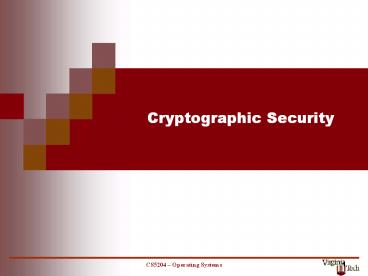Cryptographic%20Security PowerPoint PPT Presentation
Title: Cryptographic%20Security
1
Cryptographic Security
2
Security Considerations
- Factors
- reliance on unknown, vulnerable intermediaries
(e.g., Internet routers) - parties may have no personal or organizational
relationship (e.g., e-commerce) - use of automated surrogates (e.g., agents)
- Goals
- privacy/confidentiality - information not
disclosed to unauthorized entities - integrity - information not altered deliberately
or accidentally - authentication - validation of identity of
source of information - non-repudiation - source of information can be
objectively established
- Threats
- replay of messages
- interference (inserting bogus messages)
- corrupting messages
3
Cryptography
CA
M
public information
C
M
M
E
D
Ke
Kd
Decryption key
Encryption key
Forms of attack ciphertextonly
knownplaintext chosenplaintext
4
Forms of Cryptosystems
- Private Key (symmetric)
- A single key is used for both encryption and
decryption. - Key distribution problem a secure channel is
needed to transmit the key before secure
communication can take place over an unsecure
channel. - Public Key (asymmetric)
- The encryption procedure (key) is public while
the decryption procedure (key) is private. - Requirements
- 1. For every message M, D(E(M)) M
- 2. E and D can be efficiently applied to M
- 3. It is impractical to derive D from E.
5
Combining Public/Private Key Systems
Public key encryption is more expensive than
symmetric key encryption For efficiency, combine
the two approaches
- Use public key encryption for authentication
once authenticated, transfer a shared secret
symmetric key - (2) Use symmetric key for encrypting subsequent
data transmissions
6
Secure Communication - Public Key System
7
RivestShamirAdelman (RSA) Method
M
C
Cd mod n
Me mod n
User Y
User X
(e, n)
(d, n)
Encryption Key for user Y
Decryption Key for user Y
8
RSA Method
1. Choose two large (100 digit) prime numbers, p
and q,and set n p x q 2. Choose any large
integer, d, so that GCD( d, ((p1)x(q1)) 1
3. Find e so that e x d 1 (modulo
(p1)x(q1)) Example 1. p 5, q 11 and n
55. (p1)x(q1) 4 x 10 40 2. A
valid d is 23 since GCD(40, 23) 1 3. Then e
7 since 23 x 7 161 modulo 40 1
9
(Large) Document Integrity
- Digest properties
- fixed-length, condensation of the source
- efficient to compute
- irreversible - computationally infeasible for
the original source to be reconstructed from
the digest - unique - difficult to find two different sources
that map to the same digest (collision
resistance) - Also know as fingerprint
- Examples MD5 (128 bits), SHA-1 (160 bits)
10
(Large)Document Integrity
11
Guaranteeing Integrity
12
Digital Signatures (Public Key)
Requirements unforgable and unique
receiver knows that a message came from the
sender (authenticity) sender cannot deny
authorship( non-repudiation) message
integrity sender receiver message contents
preserved (integrity)(e.g., cannot cutandpaste
a signature into a message) Public Key System
sender, A (EA public, DA private)
receiver, B (EB public, DB private)
sender(A) C EB (DA (M)) gt receiver(B)
receiver(B) M EA (DB (C)) gt M
13
Secure Communication (Public Key)
Handshaking
EPKB, (IA, A)
EPKA (IA, IB)
B
A
EPKB (IB)
IA, IB are nonces nonces can be included in
each subsequent message PKB public key of B
PKA public key of A

